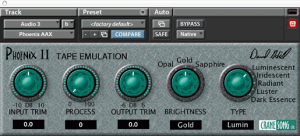Crane Song Announces Phoenix II – Now in AAX Format
With all of the great new gadgets and software being unveiled this last weekend at AES, there are still plenty of other surprises out there that you should know about. The next-gen Crane Song Phoenix II being one of them! For years, Crane Song’s Phoenix plug-in has been renowned to top mixes off with its “unique properties of a magnetic tape machine”…so long as you had a Pro Tools rig that could support the original TDM format.
Now with the announcement of Pro Tools 10 and its new AAX format, the Phoenix II will be available for not only the new Pro Tools HDX DSP systems, but also the Pro Tools HD Native systems (Questions about the new Pro Tools? See our overview here).
The plugin is available now for $450 MSRP with the Mac version available by November 1st. For more information on the plug-in, read on for data straight from Crane Song:
“Designer Dave Hill has crafted this software with the same attention to detail he used to create the electronics for ATR Service’s much heralded ‘Aria’ discrete tape recorders. His intimate knowledge of analog electronics, as well as decades of experience as a recording engineer has spawned a very useful, musical suite of plug-ins. The Phoenix II process not only incorporates the nonlinear saturation characteristics created by magnetic tape itself, but also includes the interrelation of an analog tape recorder’s record/reproduce electronics and equalization curves. Phoenix II is a ground-up application derived from HEDD technology, and specifically engineered and optimized for Avid’s PT 10 architecture.
Phoenix II has five different tape-analog characteristics, The type is selected with a switch for easy comparison between the types, and the brightness is also selected with a switch. Gold is the position where the color is approximately flat in frequency response, with Sapphire being a brighter, and Opal being a warmer tonality. A level control determines the amount of the Phoenix II process integrated into the audio signal, and an input trim determines “how hard you hit the tape.” Because the DSP process is level dependent, the input level trim control has been improved and an output trim control has been added.
The input trim can also be used to prevent clipping in the rare cases where clipping may be a problem and bringing up the level of a track for an increased amount of color. This can be useful on material that is hitting close to or at digital zero and on material that has a low recorded level. When the input trim and output trim controls are at 0dB, (no change in gain) and no tape process is being added to the sound, the plug-in is bit accurate, meaning the output exactly matches the input.
The Phoenix II contains five separate flavors:
- Luminescent is the most neutral sounding process of the five.
- Iridescent has a similar magnetic character, but with a fatter bottom and midrange. (This plug-in is the most similar to the tape knob on HEDD-192.)
- Radiant is characterized by a more aggressive compression curve
- Dark Essence is even more aggressive. (The effect is a color with a wider frequency range-when used on a vocal Dark Essence can reduce sibilance problems by increasing the apparent loudness of the rest of the signal.)
- Luster starts more gently than the other four processes, but becomes as aggressive as Dark Essence when the process is at full scale.”







